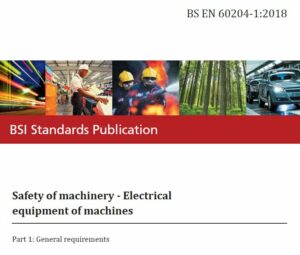BSI has published BS EN 60204-1:2018 ‘Safety of machinery – Electrical equipment of machines – Part 1: General requirements’, which supersedes and replaces the previous edition. This is the sixth edition and it contains a number of significant technical changes compared with the fifth edition. As with earlier versions, BS EN 60204-1:2018 provides requirements and recommendations relating to electrical equipment of machines in order to promote the safety of people and property, consistency of control responses, and ease of operation and maintenance.

BS EN 60204-1:2018 includes a number of significant technical changes compared with the edition it replaces.
When the fifth edition of BS EN 60204-1 was published in 2006 it was a major step forward because it accepted programmable electronic safety-related systems for the first time. Now, 12 years on, the new edition contains changes that are less radical but still important. For example, BS EN 60204-1:2018 contains requirements covering applications involving power drive systems (PDSs).
Other changes in the sixth edition include additional requirements for determining the short-circuit current rating of electrical equipment, revisions to protective bonding requirements (and terminology), and revisions to Clause 9 (Control circuits and control functions) that include requirements relating to safe torque off (STO) of power drive systems, emergency stop and control circuit protection.
Furthermore, there are revisions to EMC (electromagnetic compatibility) requirements, clarified requirements for overcurrent protection, and changes to the symbols used for actuators and control devices. The requirements relating to documentation have also been updated, as having the normative standards, bibliographical references and the list of special national conditions – the last of which will be useful for machine builders, system integrators and panel builders exporting to certain EEA countries, the USA, Canada and Japan.
One issue worth considering in more detail is the protective bonding circuit (sub-clause 8.2). This now states minimum cross-sectional areas for protective conductors that do not form part of a cable or which are not in a common enclosure with the line conductor; two values are provided, one for conductors protected against mechanical damage (eg in conduit or trunking) and the other for unprotected conductors. This is likely to be important for machine builders because guards might need to be considered part of the protective bonding circuit (this was a new requirement introduced when ISO 14120 superseded EN 953). However, sub-clause 8.2.1 does provide useful guidance on when it is not necessary to connect exposed conductive parts to the protective bonding circuit (previously this was in sub-clause 8.2.5). Sub-clause 8.2.2 (Protective conductors) is now considerably more detailed and includes a list of machine parts and electrical equipment that shall be connected to the protective bonding circuit.
Procter’s machinery safety experts have studied the 2018 edition of BS EN 60204-1 and understand the implications, particularly in relation to machine guarding. If you need assistance or guidance with adapting to the updated standard, contact Procter Machine Safety with your questions.
Find out more about the services offered by Procter Machine Safety at www.machinesafety.co.uk, or request a site meeting by telephoning 02920 855758 or emailing info@machinesafety.co.uk.
